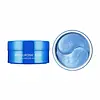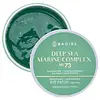What's inside
What's inside
 Key Ingredients
Key Ingredients

 Benefits
Benefits

 Concerns
Concerns

 Ingredients Side-by-side
Ingredients Side-by-side

Water
Skin ConditioningGlycerin
HumectantDipropylene Glycol
HumectantChondrus Crispus
MaskingCeratonia Siliqua Gum
EmollientButylene Glycol
HumectantGlucose
HumectantSodium Hyaluronate
HumectantPotassium Chloride
Pearl Powder
Hydroxyethylcellulose
Emulsion StabilisingCollagen
MoisturisingCyamopsis Tetragonoloba Gum
Emulsion StabilisingEthylhexylglycerin
Skin ConditioningDisodium EDTA
Parfum
MaskingCitrus Unshiu Peel Extract
MaskingAloe Barbadensis Leaf Extract
EmollientCamellia Sinensis Leaf Extract
AntimicrobialAlgae Extract
EmollientRose Extract
Skin ConditioningAnthemis Nobilis Flower Extract
MaskingPunica Granatum Fruit Extract
AntioxidantMelaleuca Alternifolia Leaf Water
AntimicrobialEucalyptus Globulus Leaf Extract
PerfumingGlycine Soja Phytoplacenta Extract
Skin ConditioningCI 77499
Cosmetic ColorantWater, Glycerin, Dipropylene Glycol, Chondrus Crispus, Ceratonia Siliqua Gum, Butylene Glycol, Glucose, Sodium Hyaluronate, Potassium Chloride, Pearl Powder, Hydroxyethylcellulose, Collagen, Cyamopsis Tetragonoloba Gum, Ethylhexylglycerin, Disodium EDTA, Parfum, Citrus Unshiu Peel Extract, Aloe Barbadensis Leaf Extract, Camellia Sinensis Leaf Extract, Algae Extract, Rose Extract, Anthemis Nobilis Flower Extract, Punica Granatum Fruit Extract, Melaleuca Alternifolia Leaf Water, Eucalyptus Globulus Leaf Extract, Glycine Soja Phytoplacenta Extract, CI 77499
Sea Water Extract
Skin ConditioningGlycerin
Humectant1,2-Hexanediol
Skin ConditioningNiacinamide
SmoothingButylene Glycol
HumectantHydrolyzed Collagen
EmollientCollagen Amino Acids
MoisturisingGlycine
BufferingGlutamic Acid
HumectantAlgae Extract
EmollientLaminaria Japonica Extract
Skin ProtectingMacrocystis Pyrifera Extract
Skin ConditioningEnteromorpha Compressa Extract
Skin ProtectingSargassum Fulvellum Extract
Skin ConditioningSpirulina Platensis Extract
Skin ProtectingAspartic Acid
MaskingLysine
Skin ConditioningHistidine
HumectantThreonine
Serine
MaskingProline
Skin ConditioningAlanine
MaskingValine
MaskingMethionine
Skin ConditioningIsoleucine
Skin ConditioningLeucine
Skin ConditioningTyrosine
MaskingPhenylalanine
MaskingCysteine
AntioxidantSh-Oligopeptide-1
Skin ConditioningSh-Oligopeptide-2
Skin ConditioningSh-Polypeptide-1
Skin ConditioningSh-Polypeptide-22
Skin ConditioningCarrageenan
Glucomannan
Skin ConditioningWater
Skin ConditioningCeratonia Siliqua Gum
EmollientEthyl Hexanediol
SolventHexylene Glycol
EmulsifyingPentylene Glycol
Skin ConditioningPropanediol
SolventPolyglyceryl-10 Laurate
Skin ConditioningCalcium Chloride
AstringentCyamopsis Tetragonoloba Gum
Emulsion StabilisingAllantoin
Skin ConditioningPinus Sylvestris Leaf Extract
TonicSucrose
HumectantHydroxyacetophenone
AntioxidantGellan Gum
Adenosine
Skin ConditioningArginine
MaskingIllicium Verum Fruit Extract
PerfumingDisodium EDTA
Dipotassium Glycyrrhizate
HumectantPropylene Glycol
HumectantEthylhexylglycerin
Skin ConditioningPolysorbate 80
EmulsifyingCaprylyl Glycol
EmollientChlorophyllin-Copper Complex
AntioxidantDipropylene Glycol
HumectantChlorphenesin
AntimicrobialParfum
MaskingSea Water Extract, Glycerin, 1,2-Hexanediol, Niacinamide, Butylene Glycol, Hydrolyzed Collagen, Collagen Amino Acids, Glycine, Glutamic Acid, Algae Extract, Laminaria Japonica Extract, Macrocystis Pyrifera Extract, Enteromorpha Compressa Extract, Sargassum Fulvellum Extract, Spirulina Platensis Extract, Aspartic Acid, Lysine, Histidine, Threonine, Serine, Proline, Alanine, Valine, Methionine, Isoleucine, Leucine, Tyrosine, Phenylalanine, Cysteine, Sh-Oligopeptide-1, Sh-Oligopeptide-2, Sh-Polypeptide-1, Sh-Polypeptide-22, Carrageenan, Glucomannan, Water, Ceratonia Siliqua Gum, Ethyl Hexanediol, Hexylene Glycol, Pentylene Glycol, Propanediol, Polyglyceryl-10 Laurate, Calcium Chloride, Cyamopsis Tetragonoloba Gum, Allantoin, Pinus Sylvestris Leaf Extract, Sucrose, Hydroxyacetophenone, Gellan Gum, Adenosine, Arginine, Illicium Verum Fruit Extract, Disodium EDTA, Dipotassium Glycyrrhizate, Propylene Glycol, Ethylhexylglycerin, Polysorbate 80, Caprylyl Glycol, Chlorophyllin-Copper Complex, Dipropylene Glycol, Chlorphenesin, Parfum
 Reviews
Reviews

Ingredients Explained
These ingredients are found in both products.
Ingredients higher up in an ingredient list are typically present in a larger amount.
Algae Extract is a confusing name. This is because algae is an informal term for a group of 30,000 aquatic organisms that can photosynthesize.
The term 'algae extract' can refer to any one, or a blend of, the 30,000 types.
Algae is rich in antioxidants. Antioxidants help fight free-radicals. Free-radicals are molecules that may damage your skin cells, such as pollution.
Algae can also help with soothing and hydrating skin.
Many different types of algae have different benefits.
Learn more about Algae ExtractButylene Glycol (or BG) is used within cosmetic products for a few different reasons:
Overall, Butylene Glycol is a safe and well-rounded ingredient that works well with other ingredients.
Though this ingredient works well with most skin types, some people with sensitive skin may experience a reaction such as allergic rashes, closed comedones, or itchiness.
Learn more about Butylene GlycolCeratonia Siliqua Gum is extracted from the seeds of the carob tree. You might know this ingredient as Carob Gum or Locust Bean Gum. It is used to stabilize other ingredients and improve the texture of products.
Carob gum is made up of long-chain polysaccharides. This makes it a natural thickener.
Yes! This ingredient comes from the seeds of a tree. The name 'Locust Bean Gum' can be misleading.
Learn more about Ceratonia Siliqua GumGuar gum is made from the guar bean, a plant native to India. It is considered a form of polysaccharide and naturally contains sugar.
This ingredient is often used to thicken a product or create a gel-like consistency.
It also has emulsion properties to help keep ingredients together.
Learn more about Cyamopsis Tetragonoloba GumDipropylene Glycol is a synthetically created humectant, stabilizer, and solvent.
This ingredient helps:
Dipropylene glycol is technically an alcohol, but it belongs to the glycol family (often considered part of the ‘good’ alcohols). This means it is hydrating and gentle on skin unlike drying solvent alcohols like denatured alcohol.
As a masking agent, Dipropylene Glycol can be used to cover the smell of other ingredients. However, it does not have a scent.
Studies show Dipropylene Glycol is considered safe to use in skincare.
Learn more about Dipropylene GlycolDisodium EDTA plays a role in making products more stable by aiding other preservatives.
It is a chelating agent, meaning it neutralizes metal ions that may be found in a product.
Disodium EDTA is a salt of edetic acid and is found to be safe in cosmetic ingredients.
Learn more about Disodium EDTAEthylhexylglycerin (we can't pronounce this either) is commonly used as a preservative and skin softener. It is derived from glyceryl.
You might see Ethylhexylglycerin often paired with other preservatives such as phenoxyethanol. Ethylhexylglycerin has been found to increase the effectiveness of these other preservatives.
Glycerin is already naturally found in your skin. It helps moisturize and protect your skin.
A study from 2016 found glycerin to be more effective as a humectant than AHAs and hyaluronic acid.
As a humectant, it helps the skin stay hydrated by pulling moisture to your skin. The low molecular weight of glycerin allows it to pull moisture into the deeper layers of your skin.
Hydrated skin improves your skin barrier; Your skin barrier helps protect against irritants and bacteria.
Glycerin has also been found to have antimicrobial and antiviral properties. Due to these properties, glycerin is often used in wound and burn treatments.
In cosmetics, glycerin is usually derived from plants such as soybean or palm. However, it can also be sourced from animals, such as tallow or animal fat.
This ingredient is organic, colorless, odorless, and non-toxic.
Glycerin is the name for this ingredient in American English. British English uses Glycerol/Glycerine.
Learn more about GlycerinParfum is a catch-all term for an ingredient or more that is used to give a scent to products.
Also called "fragrance", this ingredient can be a blend of hundreds of chemicals or plant oils. This means every product with "fragrance" or "parfum" in the ingredients list is a different mixture.
For instance, Habanolide is a proprietary trade name for a specific aroma chemical. When used as a fragrance ingredient in cosmetics, most aroma chemicals fall under the broad labeling category of “FRAGRANCE” or “PARFUM” according to EU and US regulations.
The term 'parfum' or 'fragrance' is not regulated in many countries. In many cases, it is up to the brand to define this term.
For instance, many brands choose to label themselves as "fragrance-free" because they are not using synthetic fragrances. However, their products may still contain ingredients such as essential oils that are considered a fragrance by INCI standards.
One example is Calendula flower extract. Calendula is an essential oil that still imparts a scent or 'fragrance'.
Depending on the blend, the ingredients in the mixture can cause allergies and sensitivities on the skin. Some ingredients that are known EU allergens include linalool and citronellol.
Parfum can also be used to mask or cover an unpleasant scent.
The bottom line is: not all fragrances/parfum/ingredients are created equally. If you are worried about fragrances, we recommend taking a closer look at an ingredient. And of course, we always recommend speaking with a professional.
Learn more about ParfumWater. It's the most common cosmetic ingredient of all. You'll usually see it at the top of ingredient lists, meaning that it makes up the largest part of the product.
So why is it so popular? Water most often acts as a solvent - this means that it helps dissolve other ingredients into the formulation.
You'll also recognize water as that liquid we all need to stay alive. If you see this, drink a glass of water. Stay hydrated!
Learn more about Water